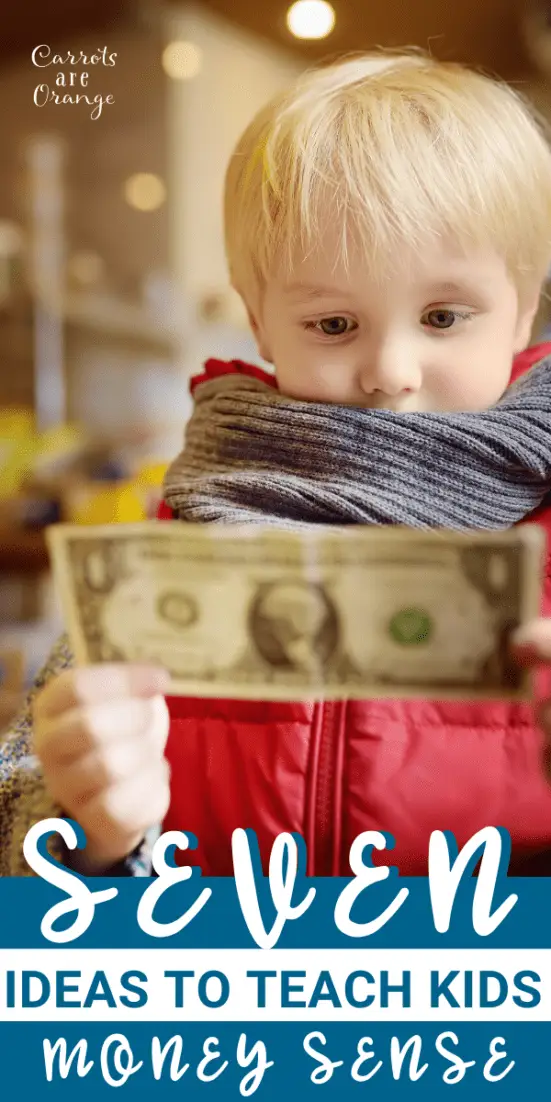Sound financial literacy begins at home. Here are several things you need to do to teach kids money sense and the value of a dollar. Share these ideas with your kids when you teach them about money management, and you will be golden.

Yes, seven things. Seriously, if you do these three things only and nothing else, your children will be in a better position financially. You might be shaking your head at this opening statement. Especially if you’ve been reading my blog for a while, you know teaching kids money is a popular topic.
I have written about a myriad of activities and ideas for parents and teachers. Still, I boil the key message down to three points to teach kids money sense.
Believe it or not, there are ways to teach kids, even our youngest children, these big life concepts. Trust me on this one.
Sadly, 26 states offer little to no financial curriculum to their high school students (Source: The Center for Financial Literacy at Champlain College). In addition, research shows that only 24% of adults (18-34 years old) answered 4 out of 5 questions (on interest rates, inflation, bond price, mortgage, and risk) correctly on a financial literacy quiz (See the report: The Financial Capability of Young Adults). That percentage for Baby Boomers was 48%.
The future financial intelligence of our kids’ generation doesn’t look promising, but there is time.
7 Things You Need to Do to Teach Kids Money Sense
#1 – Let Kids Make Financial Mistakes
We have heard this point many times over the last several years. Allowing a child to fail is one of the most effective ways to teach resilience and effective decision-making. Bringing that same idea into context with money is a whole other ballgame.
So, take a step back and get a grip on your mindset to prepare to teach kids money sense. I am not suggesting letting a child gamble away thousands of dollars. There are plenty of low-risk opportunities every day that lend well to this lesson.
For example, my six-year-old recently used his own money to purchase what I knew to be a cheap toy from a local toy shop. I know what you’re thinking, I should have stepped in, but I held myself back.
I didn’t intervene, wondering what might come of this scenario. Sure enough, he was miserable. The toy broke within minutes of getting it home. He was in tears, but his lesson was loud and clear. To quote him, “I am never going to buy junk again!”
#2 – Teach Kids the Concept of Compounding Interest
Nothing is more depressing than dollars sitting in a 0.0025% interest savings account. As I mentioned, you don’t have to invest millions of dollars to see a real impact. For younger kids, if they don’t already have an account at a bank, create your own “FAMILY” bank.
Use a spreadsheet to put in dollar amounts, add an equation for interest, and watch the money grow. Kids’ eyes widen at the magic of compound interest. If my approach is too basic for you, check out this amazingly impressive Family Bank application called FamZoo.com.
To make a point, I made interest compound daily at 20% (would that be nice!) but soon adjusted it more in line with today’s standards. Once a child is old enough to have her own account, create an investment strategy together, and start investing! Experience is a wonderful teacher.
#3 – Prepare Yourself
This point to teach kids money sense is often overlooked by us adults. If you take the time to prepare yourself, the results will be powerful. This step is not an easy one. It requires you to take a good hard look at your financial habits, history, and desires for your family.

#4 – How to Budget for Savings
Kids model their parents’ behavior. If you routinely purchase items on impulse when payday arrives, then spend the rest of the week counting change for gas, your kids are also prone to impulsive spending. When your kids see you make frugal and well-considered shopping choices, the young ones may roll their eyes, but they learn that people survive without indulging their every whim.
When children are old enough, usually by third or fourth grade, pay each child a small weekly allowance. Scale the allowance for grade and/or household chore performance. Offer bonuses from time to time for exceptional work and effort.
Let the newness of having their own money wear off by allowing your child to make a few weeks of frivolous purchases. Then, wait until the child expresses an interest in having a new toy or game. Sit down and help your child determine how many weeks of allowance they need to save to purchase the exciting new game or toy they want to own.
If your child decides not to save their allowance for four weeks to buy the desired action figure or video game, don’t give in and purchase the item for them. In four weeks’ time, do remind the child in a matter-of-fact, non-judgmental way that they could own their desired item that day had they saved their money. Let them decide for themselves whether saving is worth the temporary sacrifice.
#5 – How to Manage Household Finances
When kids approach the teens and beyond, allow them to manage or audit the household expenses from time to time. Real-life household budgeting is an eye-opener for many kids who take over (supervised) management of their families’ household incomes and expenses for a month. Kids who complain about keeping up with the Jones’ kids often have total changes of heart when they learn exactly how much money it takes to keep the refrigerator full and the lights on after dark.
Let teens start their household budgeting lessons at the grocery store. Give kids a day’s or week’s worth of grocery money to purchase enough food to last for all household meals. Help the kids create a menu plan to shop by, or let several siblings work out the meal-planning details between themselves for a more adventurous financial lesson.
Of course, kids need guidance during this kind of budgeting project to avoid stocking up on energy drinks and cupcakes for a week’s worth of breakfasts, lunches, and dinners. Set some rules for the shopping trip like only allowing $10 for sweets or requiring the kids to purchase at least four bags of fresh fruit.
Offer a bonus if the kids create a healthy menu plan under the set budget. Budgeting is hard for adults, and doubly hard for impulsive little ones, but budgeting lessons are worth the time. Your child learns to sacrifice now to pay for important expenses later. Budgeting also teaches kids how to carve out extra funds for savings and investments later in life.
#6 – How to Assess the Risks and Rewards of Investments
Most kids and many adults are clueless about the risks and rewards involved in investment schemes. All kids should be taught a few basic lessons about the types of investments available and how the risks and rewards of each type of investment correlate. Below is a simple guide to common investments and their risk/reward features.
At the top of the high-risk pile are collectibles like gaming cards, fine art, classic vehicles, and fashion pieces. Collectibles offer the highest potential for excellent returns but no guarantee of actual gains.
Moderate- to high-risk investments include stocks, corporate bonds, and mutual funds. While relatively risky, stocks, corporate bonds, and mutual funds offer the second-best potential to create significant income.
Government bonds and real estate are mid- to low-risk investments that offer moderate to low returns on the initial investment. Real estate investment involves tangible property that can function as living quarters or an income-producing rental unit.
The safest and lowest-return investments include:
- Bank savings accounts
- Cash
- Bank certificates of deposit
- Money market accounts
Teach your kids about the liquidity of investments, so they understand that $40 worth of stock can’t be spent today at the movie theater or convenience store. Help kids understand the fees and other costs associated with investments, too.
Start Virtual Bank Accounts
Encourage kids of all ages to start fantasy accounts (such as Bankaroo, which my family uses) where they track the stock performance of their favorite companies. Or, start a custodial account for your child to let them experience the market with their own money on the line.
Kids who are fascinated with specific stocks learn about the up-and-down patterns of the market and how holding on to under-performing stocks can pay off in the long run.
As part of their investment-risk education, discuss with your kids how to recognize online money scams and shady investment schemes. Teach kids about the various financial professionals who can assist them with their investment accounts in the future.
#7 – How to Maximize Individual Tax Status
Some parents are wary of starting investments for their kids. They worry about creating additional tax burdens for their offspring or themselves. The good news is that unless you’re investing substantial amounts in your kids’ names, your kids can earn modest investment income before paying any federal taxes on their earnings. They enjoy special tax-exempt status as children, up to a point.
According to the “Kiddie Tax Rule” established by the Internal Revenue Service, a child without any other earnings enjoys tax freedom on their first $1,050 of investment income. The child’s next $1,050 investment income is taxed at a lower 0-percent to a 10-percent rate depending on the capital gains’ long- or short-term status and whether or not the dividends are qualified.
Kiddie Tax Rule
After the child’s investment income totals $2,100, all of the child’s additional investment income is taxed at standard rates. Thanks to the Kiddie Tax Rule, your child can enjoy a modest amount of low-tax, unearned income to save for college or their first car.
Let kids watch while you calculate taxes on household and investment income. Or, calculate the taxes in the serenity of your office, then share the results with your kids. Show kids how their tax status and yours affect your total tax rates. Teach them about some of the ways people lower their overall tax burdens.
Speak with your kids often in age-appropriate ways about everyday financial decisions. Use the moments when kids ask about money, taxes, and the stock market to feed their interests in investments and other financial choices.
Ask your financial advisor if they have any teaching materials for kids or if they can recommend kid-friendly teaching materials. The more you expose your kids to various aspects of financial literacy, the better they’ll be at navigating their finances in the future.
I hope you found these keys steps useful in teaching your kids about money.
Marnie
